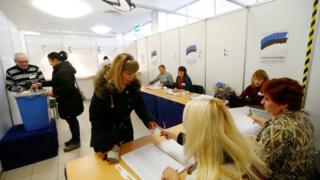 Image copyright
Image copyright
Reuters
Officials hope a lacklustre campaign does not affect turnout
Estonians have voted in a general election that pits the ruling Centre party against the liberal Reform party and a strong populist challenge.
Prime Minister Juri Ratas of the Centre party currently leads Estonia in a four-party coalition.
Polls suggest a tight vote, with Reform recently gaining on Centre.
The eurosceptic Conservative People’s Party of Estonia (EKRE), which has called for a referendum on EU membership, looks set to come third.
Nearly a quarter of Estonia’s 881,000 eligible voters cast their ballots by e-voting.
Estonia uses proportional representation to pick members in its 101-seat parliament, and results are due at midnight.
What’s the current situation?
Mr Ratas took power in November 2016 at the head of a centre-left coalition, after Reform party Prime Minister Taavi Roivas’s government collapsed.
Mr Roivas won the last election in 2015, becoming the youngest prime minister in Europe.
Image copyright
AFP/Getty
Prime Minister Juri Ratas and his Centre party face a strong challenge from liberal rivals Reform and from Eurosceptic populists
Both Centre and Reform strongly support EU and Nato membership, and have alternated in power since the country’s independence from the Soviet Union in 1991.
The two main parties support continued austerity policies, which have left Estonia with the lowest debt level of any Eurozone country but have caused anger in rural communities who feel left behind.
What are the main issues?
Reform and Centre have campaigned on tax changes, the former to help job creation and the latter to boost state revenues.
EKRE, which has pushed anti-immigration rhetoric, is promising to slash taxes.
The party only took seven seats in the 2015 general election but looks set to gain ground.
Estonia’s Russian minority, who make up a quarter of the population, are also a key issue in the campaign.
The Centre party wants to maintain the joint Estonian- and Russian-language school system – something both Reform and EKRE plan to abolish.
About five or six other smaller parties are also expected to win seats in the parliament, which could make forming coalitions tricky.
Culled from: Source


